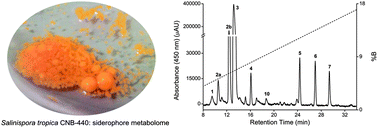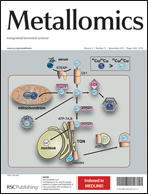The variable hydroxamic acid siderophore metabolome of the marine actinomycete Salinispora tropica CNB-440
Abstract
The recently sequenced genome of the marine actinomycete Salinispora tropica CNB-440 revealed a high frequency of gene clusters which code for the biosynthesis of known and novel secondary metabolites. Of these metabolites, bioinformatics analysis predicted that S. tropica CNB-440 could potentially biosynthesize, as high affinity Fe(III) ligands, siderophores from the hydroxamic acid desferrioxamine class (sid1 gene cluster) and the phenolate-thia(oxa)zoli(di)ne class (sid2 and sid4 gene clusters). In this work, we have used Ni(II)-based immobilized metal ion affinity chromatography (IMAC) to pre-fractionate the hydroxamic acid siderophore metabolome of S. tropica CNB-440 from the secondary metabolome, to reveal low abundance siderophores. LC-MS measurements and electronic absorption spectra from purified extracts incubated with exogenous Fe(III) revealed eight siderophores from the desferrioxamine class (DFOA2, DFOA1a, DFOA1b, DFOB, DFON, DFOD2, DFOE, DFOD1), which included two constitutional isomers (DFOA1a, DFOA1b), and one new siderophore (DFON), the latter which would require assembly from a combination of 1,5-diaminopentane and 1,6-diaminohexane as diamine substrates. Three additional species (m/zobs 496.14, 792.34 and 804.34) with electronic absorption spectra characteristic of complexes formed between Fe(III) and hydroxamic acid-type siderophores were evident under some conditions. The signal at m/zobs 792.34 eluted in the hydrophobic region of the reverse-phase LC and correlated with a DFOD1 analogue with a C-terminal branched chain fatty acid ([M + K+]+m/zcalc 792.35), which has been previously identified from marine sediment dwelling Micrococcus luteus KLE1011. The S. tropica CNB-440 hydroxamic acid siderophore metabolome was modulated by culture conditions (pH 7, 22 °C; pH 7, 28 °C; pH 9, 28 °C) designed to simulate the variable marine environment. An increase in temperature at constant pH value showed increased levels of DFOA2 and DFOA1, and decreased levels of DFOB and DFOE. An increase in pH value at constant temperature showed decreased levels of DFOA2 and DFOA1, and increased levels of DFOB, DFON and DFOE. These results indicate that the marine adaptation of S. tropica CNB-440 could involve its ability to select a suite of siderophores from a large number of candidates, which are optimized for the iron microenvironment.


 Please wait while we load your content...
Please wait while we load your content...